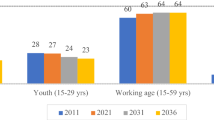Abstract
Using the NSSO data on Employment and Unemployment, this paper examines issues of employment and unemployment among Indian youth belonging to various social and religious groups since the advent of the economic reforms in the early 1990s. It shows how an increasing proportion of the youth population is facing situations of high open unemployment during a period of high economic growth. The predominance of the poor quality of employment available to youths is also a major issue of concern, especially for those belonging to the Scheduled Castes, Scheduled Tribes and Muslim communities. Using the Logit Model, the paper shows how education, gender, social belonging and location play significant roles in determining youths participation in labour force, education and quality of employment. The paper argues for strengthening measures to create decent employment on a large scale and for improving the education and skill levels of youths with a greater focus on those belonging to the marginalised groups of Indian society.


Similar content being viewed by others
Notes
We consider the population aged 15–29 years as youth for our analysis in the present paper. Many programmes of the Government of India aimed at youth also cover the age group of 15–29 years.
By using the UPSS approach, students working in their subsidiary capacity get included as workers. However, such number is not large, thus not affecting the overall trends.
This has been largely attributed to overestimation of work as ‘unpaid family workers’ (for details see Ghose 2013).
See Ghose (2013) for overestimation of workforce in 2004–2005.
References
Aiyar S, Mody A (2011) The demographic dividend: evidence from the Indian States. IMF Working Paper WP/11/38
Bloom D, Canning D (2004) Global demographic change: dimensions and economic significance. NBER Working Paper 10817. National Bureau of Economic Research, Cambridge
Chadha GK (2000) Youth unemployment in India: past policy gaps and future strategic options. Indian J Labour Econ 43: 591–624
Chandrasekhar CP, Ghosh J, Roychowdhury A (2006) The demographic dividend and young India’s economic future. Econ Political Weekly 41:5055–5064
Cramer, C (2010) Unemployment and participation in violence. World Development Report 2011 Background Paper. School of Oriental and African Studies, 16 November, London
Dev SM, Venkatanarayana M (2011) Youth employment and unemployment in India, WP-2011–009. Indira Gandhi Institute of Development Research (IGIDR), Mumbai
Freidrich Ebert Stiftung (FES) (2012) Youth agenda for India: a study. Young Leaders Think Tank, Friedrich-Ebert -Stiftung, New Delhi
Ghose AK (2013) The Enigma of women in the labour force. Indian J Labour Econ 56:635–642
GoI-RGI (2012) Primary census abstract of India. Registrar General of India, Government of India, New Delhi
Hirway I (2014) Unpaid work and the economy: linkages and their implications. In: Presidential address at the 56th annual conference of the Indian Society of Labour Economics, Ranchi, December
IAMR (2011) India human development report. Oxford University Press, New Delhi
IHD-ISLE (2014) India labour and employment report 2013-workers in the era of globalisation. Institute for Human Development and Indian Society of Labour Economics. Academic Foundation, New Delhi
India Skills Report (2014) People strong, confederation of indian industry (CII) and wheelbox. Gurgaon, Haryana
International Labour Organisation (ILO) (2013) Global employment trends for youth: a generation at risk. ILO, Geneva
Mamgain RP (2010) Tackling high level skills shortages in India. Paper prepared for ILO G20 meeting of experts on skills to meet global challenges, (mimeo), March. International Training Centre-ILO, Turin
Mamgain RP (2013) Situating scheduled castes and scheduled tribes in the post-2015 development framework. Oxfam India Working Papers Series, June. Oxfam, New Delhi
Mamgain RP, Tiwari S (2015) Youth in India: challenges of employment and employability. Giri Institute of Development Studies, Working Paper, No. 215
Mitra A, Verick S (2013) Youth employment and unemployment: an Indian perspective. ILO Asia Pacific Working Paper Series, March, New Delhi
Munshi K (2011) Strength in numbers: networks as a solution to occupational traps. Rev Econ Stud 78:1069–1101
Neff D, Sen K, Kling V (2012) The puzzling decline in rural women’s labour force participation in India: a reexamination. GIGA Research Unit: Institute of Asian Studies, No. 196, May
NSSO (2014) Employment and unemployment situation in India, 68th round. National Sample Survey Organisation, New Delhi
Papola TS, Sahu PP (2012) Growth and structure of employment: long-term and post-reform performance and emerging challenges. Occasional Paper Series, 2012/1, ISID. Institute for Studies in Industrial Development, New Delhi
Planning Commission (2008) Development challenges in extremist-affected areas. Report of Expert Group to the Planning Commission, April
Planning Commission (2013) Faster, sustainable and more inclusive growth, twelfth five year plan 2012–2017, vol 1. Sage Publications, New Delhi
Rangarajan C, Kaul PI, Seema (2011) Where is the missing labour force? Econ Political Weekly 39:68–72
Thorat S, Newman K (2010) Blocked by caste: economic discrimination in modern India. Oxford University Press, New Delhi
World Bank (2013a) Youth employment—a human development agenda for the next decade, by David Robalino, David Margolis, Friederike Rother, David Newhouse and Mattias Lundberg, Social Protection and Labour, Working Paper No. 1308, Washington DC, June
World Bank (2013b) Inclusion matters—the foundation for shared prosperity, Washington DC
Acknowledgments
The authors express their thanks to the Conference participants for their useful comments. Special thanks are due to Ajir K. Ghose, Arjan de Haan and Arup Mitra for their valuable comments.
Author information
Authors and Affiliations
Corresponding author
Appendix
Appendix
Rights and permissions
About this article
Cite this article
Mamgain, R.P., Tiwari, S. Youth in India: challenges of employment and inclusion. J. Soc. Econ. Dev. 18, 85–100 (2016). https://doi.org/10.1007/s40847-016-0025-8
Published:
Issue Date:
DOI: https://doi.org/10.1007/s40847-016-0025-8




